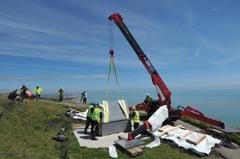Readers projects : Bomber Command Memorial Beachy Head
The 70m long Portland stone memorial to Bomber Command in London unveiled by The Queen grabbed the limelight, but on the South coast at Beachy Head a more modest memorial was lowered by RAF helicopter on to the last point of England tail gunner Joe Williams saw as he flew out on bombing raids. For many of his comrades it was the last they ever saw of England.
For decades, tail gunner Joe Williams wanted a memorial to Bomber Command on Beachy Head in Sussex. As far as he was concerned, this was the most relevant and poignant site for it because the 162m-high landmark was the last view air crews had of England as they flew off on raids into Germany from which half of them never returned.
In 2008, when the Bomber Command Association began a campaign to raise money for a memorial to commemorate the 55,573 men who lost their lives in the bombers, Joe put in a bid for a memorial at Beachy Head. He wrote to a wide range of people involved in the campaign but they had already decided the memorial would be in London and Joe says they did not even bother to reply to his letters.
So he started his own campaign to raise the funds for a memorial on Beachy Head. He gained the support of local MPs and the council, who eventually gave him planning permission to erect a memorial on the highly protected cliff tops.
Joe is now 90 and lives in Devon. After one false start with a stone company in Essex, he approached a memorial mason near to where he lives – Vince Orchard, who runs Orchard Memorials.
Vince in turn emailed the Thomas Group, the stone wholesalers in Manchester. Peter Thomas happened to be taking his son to the Royal Marine base at Exmouth to start his officer training the next day, so he called in to see Vince while he was there. Vince has since become a regular customer.
The Thomas Group was able to source a two-part, six tonne polished granite memorial in what they call Truro granite from China. It is 1.8m long, 1.8m high and a metre wide.
The inscription and designs on it were added in this country using masks and sandblasting. The blocks were too big to fit into the company’s sandblasting cabinet so a tent was set up in the yard to contain the dust and the work was carried out in that. The lettering and motifs are picked out in black paint.
Then there was the challenge of getting not only the two parts of the memorial but also a crane to lift it into place to the site on Beachy Head where it was to be positioned. The planning permission allowed access to the land around the memorial site but access across the SSSI to reach it was restricted.
GGR Group supplied a crane and an operator free of charge to lift the memorial into position, but the problem of actually getting to the site remained.
It was solved by the RAF, who supplied a Chinook helicopter from RAF Odiham to lift first the crane and then the memorial on to the cliff top site at Beachy Head.
Clearly six tonnes of granite is going to need some support and concrete foundations had been laid ready to receive the memorial, with 50mm thick paving slabs around it.
Although the weather turned out to be exceptionally calm on 26 June when the lift took place, six tonnes of granite hanging from a line under a Chinook was not going to be positioned accurately, which was why the crane was needed.
Both the crane and the memorial were lifted to the site where the memorial was to be installed and the crane was used for the final positioning and fixing by Vince Orchard. The memorial sits on location pins but is not anchored as it was felt six tonnes of granite would not be going anywhere.
There had to be 10mm spacers between the top and bottom stones so the lifting straps could be removed after the top block had been lifted into place. It was positioned on pins resined into the granite and a silver sand and cement mortar fills the gap.
On 28 June, The Queen, accompanied by 10 other members of the royal family, unveiled the 70m long, £7.5million Portland limestone Bomber Command Memorial on the edge of Green Park in London (see the previous pages). On 8 July the more modest tribute on Beachy Head was dedicated, followed by a reception at the Royal Air Force Association Club in Eastbourne.

